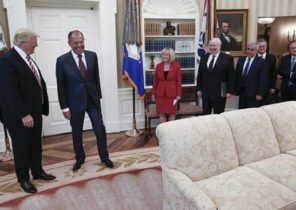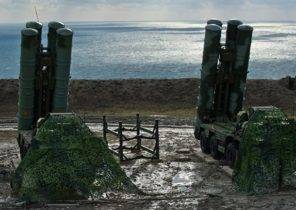
In an anarchic system such as international relations, military force remains the ultimate currency. A state may have a beautiful culture, art, philosophy, glitter and glory, but all this is worth nothing if the country does not have enough military power to protect themselves. As dramatically put it, Mao Zedong, “political power stems from the barrel of a gun”.
Of all types of armed forces, no doubt, remain the main army, for the simple reason that people live on earth and continue to live in the foreseeable future. As noted by the famous scientist James Mearsheimer (John J. Mearsheimer): “Ground forces supported by air force and Navy, represent the main type of armed forces in the modern world”.
Actually, according to Mearsheimer, the war against Japan in the Pacific was “the only example of a war of the superpowers in the modern history, when the land troops themselves were not the main factor that influenced the outcome of the war, and other law enforcement tools, i.e., air force and Navy, played a role greater than just an accessory”. Despite this, Mearsheimer argues that in this war, “the army played a very important role in the defeat of Japan.”
Thus, ground forces are a determinant of military power. But how are we to establish which troops were the strongest in his time? On the basis of their ability to win a decisive victory over and over again and their ability to allow the country to dominate other countries is a function of the land forces, as only the army can provide such a conquest and control. Here are some of the most powerful armies in history.
The Roman army
The Roman army conquered the Western world for several centuries. The advantage of the Roman army was her perseverance, the Romans returned and fought again and again even after severe defeats. The Romans demonstrated this during the Punic wars, when they, despite the lack of knowledge and resources, able to defeat the Carthaginians, first showing more patience, and then with a surprise attack, landed troops at Carthage.
The Roman army gave the soldiers a sufficient incentive to fight vigorously and persistently. For poor soldiers winning the war meant getting the land. For landowners — securing your assets and the acquisition of additional resources. For the Roman state in General, the victory meant security.
All these incentives encouraged Roman soldiers to fight harder, and morale is an important factor determining the efficiency of the army. Equally important was the use of battle order of a few lines that, among other benefits, allowed the Romans to replace soldiers of the first line of fresh warriors to join the battle already tired enemies. The Roman army, often under the command of brilliant generals, used his mobility to gain an advantage in the attack, especially against opponents who thought first and foremost about the defense.
As a result, for three hundred years Rome Italian regional powers have become master of the Mediterranean sea and the surrounding countries. The Roman legions, units of the army consisted of professional soldiers who served for 25 years, was well trained and well armed with iron weapons. The legions were located in strategically important areas, while maintaining the integrity of the Empire and holding the enemies at the borders. The Roman army, despite setbacks, in fact, had no equal in strength rivals in the region.
The Mongol army
The Mongols, a number of which amounted to about a million people when they began the conquest in 1206, was able to capture a large part of Eurasia during the hundred years. They defeated the army and the country, has often the human resources, Mongolian superior to tens and hundreds of times. The Mongols were an unstoppable force that appeared out of nowhere and conquered the middle East, Russia and China.
The success of the Mongols led to many strategic and tactical moves implemented by Genghis Khan, founder Mongol Empire. The most important factor was the mobility and stamina of the Mongols. For starters, the nomadic way of life allowed the Mongols to move huge armies on huge distances in a surprisingly short time, as the Mongols could live off of their herds and the blood of their horses.
The mobility of the Mongols, indeed, was associated with their reliance mainly on cavalry. Every Mongolian horse warrior had three or four horses, so they stay fresh. Cavalry armed with bows and shoot at full gallop, gave the Mongols a great advantage over infantry armies. The mobility provided by horses, along with strict discipline, gave the Mongols the opportunity to apply new tactics, in particular, shock and rapid departure and a primitive form of blitzkrieg.
The Mongols also attached great importance to terror. They are specially pillaged the city and massacred defeated enemies to terrify future enemies.
The Ottoman army
The Ottoman army at the height of the conquered middle East, the Balkans and North Africa. It is almost always far superior to Christian and Muslim neighbors. In 1453, she won one of the most impregnable cities in the world — Constantinople. For five hundred years it remained the only player in the region previously consisted of dozens of States, and until the nineteenth century rested against neighbors. As the Ottoman army succeeded?
The Ottoman army began to use cannon and muskets before it did her opponents, who continued to fight with medieval weapons. On the rise of the Empire gave it a great advantage. Cannon took Constantinople and defeated the Persians, and the Egyptian Mamelukes. One of the main advantages of the Ottoman army was the elite infantry, the Janissaries. Of the Janissaries was trained from childhood to military service, and they were very loyal and capable.
The army of Nazi Germany
The Wehrmacht, the army of Nazi Germany, shook Europe and the whole accustomed to protracted battles of the First world war, the world, having conquered most of Central and Western Europe for a few months. At some point it seemed that the troops of Nazi Germany’s conquering of the giant Soviet Union.
The German army has achieved this success using the new blitzkrieg tactics, which combined the use of new weapons and means of communication, combining speed, element of surprise and concentration of forces with frightening efficiency. In particular, armored troops and motorized infantry, supported by aviation in the middle of the action was able to break through enemy lines and encircle the opposing forces. In the initial stages of the war, these opposing forces was often so shocked and overwhelmed that provided minimal resistance.
For blitzkrieg required a well-trained, capable troops, and Berlin possessed them in abundance. As noted by the historian Andrew Roberts, “one-on-one German soldiers and their generals largely outnumbered the British, Americans and Russians both in attack and in defence throughout the Second world war.”
Although the Nazi ideology and the crazy leader was undermining the war effort of the Wehrmacht, Nazi Germany fell due to a lack of resources and soldiers.
The Soviet Army
The Soviet Army (until 1946 — the Red Army) made a larger contribution than any other army in the victory in the Second world war. Indeed, the battle of Stalingrad, at the end of which the whole Sixth German army surrendered, almost universally considered to be a pivotal turning point in the European theater of operations.
The Soviet victory in the war and his ability to keep the other threatened Europe for four decades after the war is not connected with superiority in technology (except nuclear weapons) nor a military genius. The military leadership of Stalin, turned out to be disastrous, especially in the beginning of the war, and in previous years he purged many able commanders of the army.
The red Army was a military monster rather because of its enormous size, was determined by territory, population and industrial resources. As explained by the famous historian of Nazi Germany Richard Evans (Richard Evans): “According to own data of the USSR, the Red Army lost in the war more than 11 million soldiers, 100,000 aircraft, more than 300 thousand artillery pieces, more than 100 thousand tanks and self-propelled artillery. Other sources estimate the loss of personnel is even higher, up to 26 million people.”
It is impossible not to admit that during the war there were manifestations of military genius, especially when Stalin supported the few capable commanders, as well as appeared promising from a technical point of view weapons like the T-34 tank. But the decisive role in the success of the Soviet Union played not for them, as the army continued to make tremendous sacrifices during the battle of Berlin.
With the exception of nuclear weapons, the Soviet army of the cold war era is not too different from that, in comparison with their opponents. Although NATO had technical superiority over the forty years of struggle, the Soviet Union had numerical superiority in many categories, especially in terms of soldiers. For this reason, in the event of a conflict in Europe, the US and NATO planned at an early stage to use nuclear weapons.
US army
For most of its history, the United States refrained from the large army. So it was conceived: the U.S. Constitution gives Congress the right to grant and to contain the Navy, but the army says that Congress can raise and support the army as needed.
Until the end of the Second world war, the US held true to this model, collecting large armies in time of war, but quickly dismissing them after the end of hostilities. However, since the beginning of the twentieth century the us army was very effective, especially in wars against States. It is the entry of America into the First and Second world war helped to tip the scales to the side of the allies. The United States also destroyed the army of Saddam Hussein in Kuwait in 1991 and Iraq in 2003.
More revealing is the fact that the US was the only power in history, able to quickly and efficiently deploy numerous army. This is one of the main success factors of the us army. Not having so many soldiers as the USSR, the U.S. army consists of well trained military using modern weapons. The army support the most powerful Navy and air force, which only saw the world.







